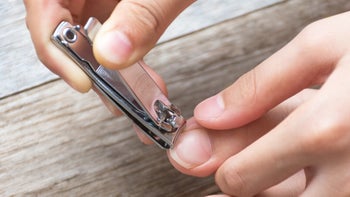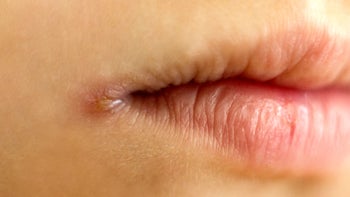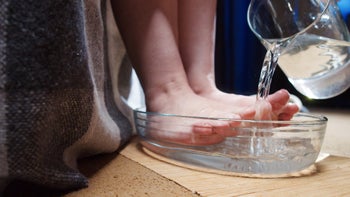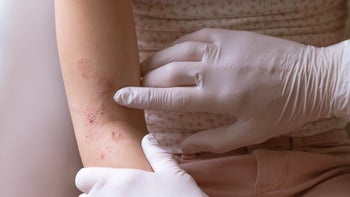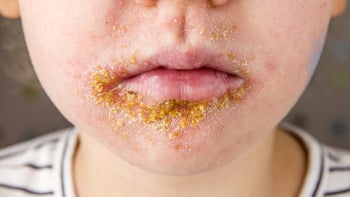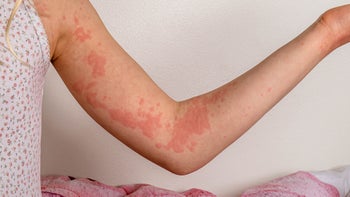
Molluscum Contagiosum: Images, Stages, and Treatment in Kids and Adults
Key takeaways:
Molluscum contagiosum is a contagious viral infection that causes a characteristic wart-like rash. It’s particularly common among children.
There are several treatment options, but these are mainly to remove the wart-like bumps rather than shorten the duration of the infection.
As frustrating as it may be, molluscum will eventually go away on its own. Typically, the rash resolves within 6 to 12 months, but it can take as long as several years.
Table of contents

Molluscum contagiosum is a common infection caused by a pox virus. It’s more common in children than adults. And it’s easily spread from person to person through direct contact. The rash starts as flesh-colored bumps on the skin, and it lasts much longer than other infections that cause rashes. Even though it usually isn’t dangerous, it can be very itchy, and some people are bothered by the appearance.
Molluscum will eventually go away on its own — but it can take several months. The good news is that there are treatments that can help.
How do you get molluscum contagiosum?
You can get molluscum contagiosum if you come into contact with the virus particles. This can occur in one of two ways:
Direct contact with a person who has the molluscum rash
Contact with objects that someone with the infection has recently touched or handled
Search and compare options
Molluscum is more common in children. That’s because the virus is highly contagious, and it’s hard to keep kids from coming into contact with it. The virus spreads easily among kids because:
Children come into contact with each other during day care, school, and contact sports.
Kids often share toys and supplies at school and day care.
Molluscum often spreads at community swimming pools, possibly through towels and toys, though experts aren’t sure exactly why this happens more at pools than other shared spaces.
Children easily spread the virus to other parts of their own bodies. This happens when they scratch the rash and then touch another part of their body.
Adults also spread the molluscum contagiosum to each other through direct contact in the same ways kids do. Adults should also be aware that the virus can spread through sexual contact.
Since the infection can be spread in this way, some parents worry when they notice their child has the rash in their groin area. But it’s helpful to know that this is much more likely to occur because the child scratched one of their own bumps, rather than being touched in the groin area.
Common rashes in kids: From viruses to scabies, see pictures of the most common children’s rashes.
How to get rid of warts: Salicylic acid and freezing therapy are the best ways to remove warts. But sometimes, you’ll need professional help.
Bumps on your face? Molluscum may not be to blame. There are many other common causes of bumps on the face.
What are the symptoms of molluscum contagiosum?
The main symptom of molluscum is the rash. It changes appearance throughout the different stages of the infection. For some people, the rash can be very itchy. But it isn’t painful.
Unlike other infections that cause a rash, molluscum contagiosum doesn’t cause additional symptoms. It doesn’t cause symptoms like:
Fever
Muscle aches
Runny nose
Cough
Diarrhea
Vomiting
If you or your child develop these symptoms with a rash that looks like molluscum, it’s important to see a healthcare professional. These symptoms could mean something other than molluscum is causing the rash. It’s also possible that one of the bumps has become infected with bacteria. The symptoms of infected molluscum contagiosum bumps are discussed in more detail below.
Pictures of molluscum bumps in different stages
The molluscum rash changes in appearance throughout the course of the infection. The total time for the virus to run its course is usually about 6 to 12 months. In rare cases, it can last up to several years.
There are different stages of the virus, and it’s common to have more than one stage at once. Let’s look at the stages of molluscum and how the rash looks in each stage.
Early stage molluscum contagiosum
In the beginning, the rash looks like pinheads: tiny, shiny, skin-colored bumps or domes. This usually happens between 2 weeks and 2 months after you came into contact with the pox virus.

Established molluscum contagiosum
As the rash progresses, the bumps get bigger (the size of a pencil eraser), and you can usually see a dimple in the middle. Sometimes, the rash also becomes itchy.

Inflamed molluscum contagiosum
As molluscum contagiosum progresses over weeks and months, it’s common for the dimple to fill with a white core. The surrounding area may also become red and irritated. Although the rash can appear worse, this stage actually means your body is starting to fight off the virus.

Healing (final) stage
After several months, the rash will slowly start to clear up. In the final stages you’ll sometimes notice some residual red or brown irritated areas.

What is the treatment for molluscum contagiosum?
There are many different approaches to treating and healing molluscum. The best treatment for you depends on several factors, like how bothersome or widespread it is.
Topical medications
Topical medications are applied directly to the molluscum spots on the skin. Some of these treatments you can apply at home. Others are done in your healthcare professional’s office. Most of these treatments take several weeks to work.
Here are some common prescription topical molluscum contagiosum treatments:
Cantharidin (Ycanth): Cantharidin is the only FDA-approved treatment for molluscum. It causes a small blister to form, which helps lift off the molluscum. Your healthcare professional will apply it once every 3 weeks in their office (usually about 4 times total).
Retinoids: You’ll typically apply retinoid creams (like tretinoin) 3 times a week at home. Retinoids cause a local skin irritation which stimulates the immune system to clear the virus.
Imiquimod (Aldara): Imiquimod is another prescription cream that you can apply 2 to 3 times a week at home. It also stimulates the immune system to fight the virus.
Podofilox (Condylox): Podofilox is a prescription cream that you can apply at home twice a day for 3 days, followed by no treatment for 4 days. It also irritates the skin and stimulates the immune system.
For over-the-counter (OTC) treatments, salicylic acid and benzoyl peroxide may be good options. You’ll apply these 3 to 4 nights a week. These treatments also cause irritation and stimulate the immune system.
Pills
Research shows that oral cimetidine (Tagamet) helps in some kids, especially those with other skin conditions like eczema. Having a skin condition may help the immune system fight off the virus more easily. But people usually need to use cimetidine in combination with other topical treatments.
Curettage
This is a procedure in which a dermatologist numbs and then scrapes off the bumps. Some people prefer this option if they have visible bumps that are bothering them (like bumps on the face). But this treatment isn’t a cure. Since the virus is still active in the body, the rash can come back elsewhere.
Freezing
The molluscum contagiosum bumps can also be frozen off with liquid nitrogen. The main disadvantage to this treatment is that it can be painful. It can also lead to scarring. And, like curettage, it isn’t a cure.
Laser
This treatment uses special laser equipment to get rid of the bumps. But, because it requires a special machine, it isn’t always an option. It can be very expensive. And it can also take a couple of treatments to work.
Home remedies
People have tried many different home remedies for molluscum over the years. Most of these treatments haven’t been well-studied, and some may actually be harmful. In general, it’s best to avoid these home remedies and opt for proven treatment approaches.
Here’s what the research says about these popular home remedies:
Duct tape: There’s very little research showing that duct tape can work for molluscum. It can also lead to skin irritation, especially in people prone to skin inflammation.
Garlic: Some reports show that garlic may help with warts, but it hasn’t been studied in molluscum.
Tea tree oil: A very small study showed that a low concentration of tea tree oil could help clear molluscum. Keep in mind that because it’s a natural product, the concentration isn’t well regulated. High doses of tea tree oil can cause burns and blisters.
Iodine: Very little research has shown that iodine can work for molluscum. Iodine shouldn’t hurt the skin, but it can cause staining and discoloration.
Apple cider vinegar: No research has shown that apple cider vinegar works on molluscum. It can actually cause chemical burns and shouldn’t be applied directly to the skin.
Zinc oxide and colloidal oatmeal: A very small study showed that this combination could help improve molluscum in some people.
No matter which treatment you try for molluscum, don’t try to pop them. This isn’t recommended. It increases the risk of a bacterial infection and scarring.
What if molluscum contagiosum bumps become infected?
The most common complication of molluscum is a secondary infection of one of the bumps. This is more likely if you’ve been scratching them a lot. This can introduce bacteria into the skin, which then turns into a second infection on top of the bumps.
A bacterial infection of the skin is called cellulitis. Signs of cellulitis include:
Increasing redness and warmth in the surrounding area
Pain or tenderness to the touch
Fevers or chills
Other flu-like symptoms, like joint pain or feeling out of it (malaise)
It’s important to note that signs of inflammation — like fluid-filled bumps and redness — are one of the natural stages of the rash. As mentioned above, this typically happens several weeks to months after the rash starts. And it’s actually a sign that your body’s immune system is fighting the rash. So, it’s typically a sign that you’re on your way to getting better.
But these changes shouldn’t cause pain or fever. So, when in doubt, reach out to your provider for evaluation. If it’s cellulitis, you may need antibiotics for treatment.
How do you prevent molluscum contagiosum?
A molluscum infection can be bothersome and last a long time. So, it makes sense to pay close attention to prevention when you or someone you know has it.
There are several ways to help limit the spread of molluscum:
Don’t touch the rash: Touching, picking, or scratching the rash are the easiest ways to spread the virus. So, if you have molluscum, avoid touching, picking, or scratching it.
Wash your hands: If you do touch a bump, be sure to wash your hands thoroughly with soap and water.
Cover the rash: If you or your child will be in close contact with others, keep the rash covered. In general, clothing works better than bandages. And adhesive bandages can often make irritation and itching worse.
Don’t bathe with others: If your child has molluscum, don’t bathe them with siblings or other children.
Pay attention to how you use towels: Dry off uninfected parts of the body first. Then, pat infected areas dry. Wash towels after each use. And, don’t share towels.
Keep skin moisturized: This can prevent dry skin and worsening itchiness. It can also help prevent tiny cracks in the skin, which can spread the virus even more. Unscented lotions are best to avoid further skin irritation.
Avoid shaving or electrolysis: Shaving and electrolysis can lead to tiny injuries to the skin, which allow the virus a point of entry.
Frequently asked questions
It’s contagious as long as you have active spots. This means you should keep them covered (either with a bandage or clothing), if you could come into contact with other people. Once the bumps have crusted over and healed, they’re no longer contagious.
Clean the area with mild soap and water. Then, apply Vaseline. This will help prevent it from spreading and from getting a bacterial skin infection. Avoid picking the area as it heals.
Molluscum can look similar to other common growths, like cysts, sebaceous hyperplasia, acne, warts, and even skin cancer. If you’re not sure what you have, it’s best to get checked out by a healthcare professional.
The bottom line
Molluscum contagiosum can be a pesky and persistent viral infection. And it’s very contagious. It’s commonly seen in young children, since they’re often in close contact with each other and share many toys. But adults can get it, too.
If you or someone you know has molluscum, try your best to prevent spreading the infection. But know that even with the best hygiene practices, this can be hard to avoid when you live in close contact with people. Perhaps the toughest part of this rash is that it demands patience. It can take many months to go away. But there are several options to remove any bothersome bumps as you wait for the infection to resolve.
Why trust our experts?



Images used with permission from VisualDx (www.visualdx.com).
References
Badri, T., et al. (2023). Molluscum contagiosum. StatPearls.
Bunick, C. G., et al. (2012). Chemical burn from topical apple cider vinegar. Journal of the American Academy of Dermatology.
Burke, B., et al. (2004). Essential oil of Australian lemon myrtle (Backhousia citriodora) in the treatment of molluscum contagiosum in children. Biomedicine & Pharmacotherapy.
Centers for Disease Control and Prevention. (2024). About molluscum contagiosum.
Hwang, A., et al. (2022). Integrative therapies for warts and molluscum contagiosum. Journal of Integrative Dermatology.
Lindau, M. S., et al. (2004). Use of duct tape occlusion in the treatment of recurrent molluscum contagiosum. Pediatric Dermatology.
Ludmann, P. (2023). Molluscum contagiosum: Diagnosis and treatment. American Academy of Dermatology Association.
Safa, G., et al. (2010). Successful treatment of molluscum contagiosum with a zinc oxide cream containing colloidal oatmeal extracts. Indian Journal of Dermatology.
Singh, A., et al. (2022). Podophyllin in dermatology: Revisiting a historical drug. Indian Dermatology Online Journal.
U.S. Food and Drug Administration. (2023). FDA approves first treatment for molluscum contagiosum.
van der Wouden, J. C., et al. (2017). Interventions for cutaneous molluscum contagiosum. The Cochrane Database of Systematic Reviews.




